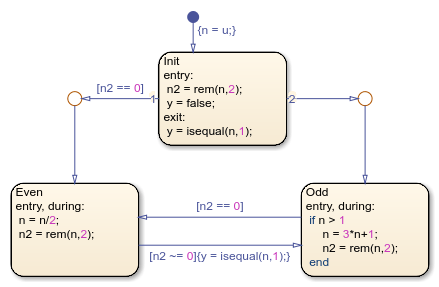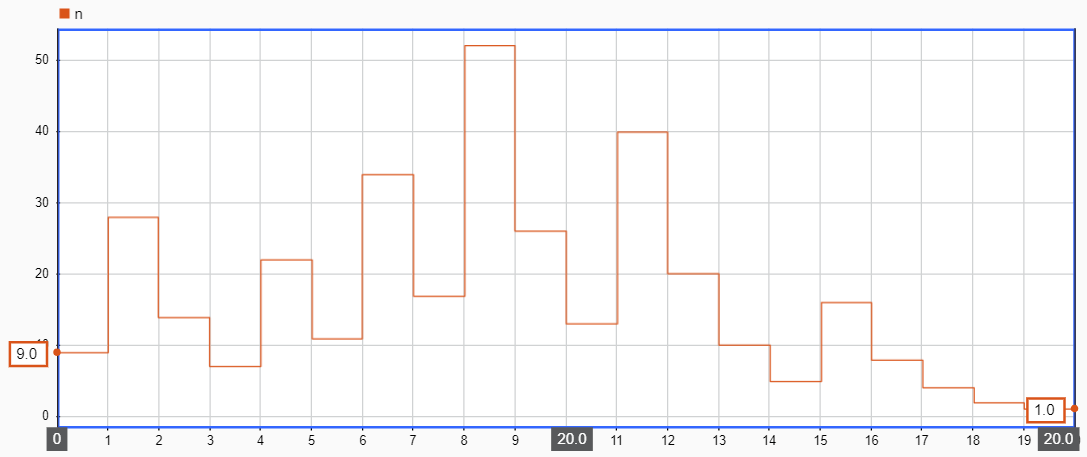Define Chart Behavior by Using State Actions and Transition Labels
State actions and transition actions are instructions that you write inside a state or on a transition, respectively, to define how a Stateflow® chart behaves during simulation. For example, the actions in this chart define a state machine that empirically verifies one instance of the Collatz conjecture. For a given numeric input  , the chart computes the hailstone sequence
, the chart computes the hailstone sequence 


 … by iterating this rule:
… by iterating this rule:
If
 is even, then
is even, then  .
.If
 is odd, then
is odd, then  .
.
The Collatz conjecture states that every positive integer has a hailstone sequence that eventually reaches one.

The chart consists of three states. At the start of simulation, the Init state initializes the chart data by setting:
Local data
nto the value of the inputu.Local data
n2to the remainder whennis divided by two.Output data
ytofalse.
Depending on the parity of the input, the chart transitions to either the Even or Odd state. As the state activity shifts between the Even and Odd states, the chart computes the numbers in the hailstone sequence. When the sequence reaches a value of one, the output data y becomes true and triggers a Stop Simulation (Simulink) block in the Simulink® model.
State Action Types
State actions define what a Stateflow chart does while a state is active. The most common types of state actions are entry, during, and exit actions:
entryactions occur when the state becomes active.duringactions occur on a time step when the state is already active and the chart does not transition out of the state.exitactions occur when the chart transitions out of the state.
You can specify the type of a state action by using a complete keyword (entry, during, exit) or an abbreviation (en, du, ex). You can also combine state action types by using commas. For instance, an action with the combined type entry, during occurs on the time step when the state becomes active and on every subsequent time step while the state remains active.
The hailstone chart contains actions in these states:
Init— When this state becomes active at the start of the simulation, theentryaction determines the parity ofnand setsytofalse. When the chart transitions out ofInitafter one time step, theexitaction determines whethernis equal to one.Even— When this state becomes active, and on every subsequent time step that the state is active, the combinedentry, duringaction computes the value and parity for next number of the hailstone sequence,n/2.Odd— When this state becomes active, and on every subsequent time step that the state is active, the combinedentry, duringaction checks whethernis greater than one and, if it is, computes the value and parity for next number of the hailstone sequence,3*n+1.
Transition Label Types
Transition labels define what a Stateflow chart does when the active state changes. The most common types of transition labels are conditions and condition actions.
[Condition]{ConditionAction}
Condition is a Boolean expression that determines whether the transition occurs. If you do not specify a condition, the transition occurs one time step after the source state becomes active.
ConditionAction is an instruction that executes when the condition that guards the transition is true. The condition action takes place after the condition but before any exit or entry state actions.
The hailstone chart contains actions on these transitions:
Default transition into
Init— At the start of the simulation, the condition actionn = uassigns the input valueuto the local datan.Transition from
InittoEven— The conditionn2 == 0determines that the transition occurs whennis even. The number 1 at the source of this transition indicates that this transition is evaluated before the transitionInittoOdd.Transition from
OddtoEven— The conditionn2 == 0determines that the transition occurs whennis even.Transition from
EventoOdd— The conditionn2 ~= 0determines that the transition occurs whennis odd. In this case, the condition actiony = isequal(n,1)determines whethernis equal to one.
Examine Chart Behavior
To compute the hailstone sequence starting with a value of nine:
1. In the Constant block, enter a value of 9.
2. In the Simulation tab, click Run. The chart responds with these actions:
At time
 , the default transition to
, the default transition to Initoccurs. The transition action sets the value ofnto 9. The stateInitbecomes active. Theentryactions inInitsetn2to 1 andytofalse.At time
 , the condition
, the condition n2 == 0is false so the chart prepares to transition toOdd. Theexitaction inInitsetsytofalse. The stateInitbecomes inactive and the stateOddbecomes active. Theentryaction inOddsetsnto 28 andn2to 0.At time
 , the condition
, the condition n2 == 0is true so the chart prepares to transition toEven. The stateOddbecomes inactive and the stateEvenbecomes active. The entry action inEvensetsnto 14 andn2to 0.At time
 , the condition
, the condition n2 ~= 0is false so the chart does not take a transition. The stateEvenremains active. Theduringaction inEvensetsnto 7 andn2to 1.At time
 , the condition
, the condition n2 ~= 0is true so the chart prepares to transition toOdd. The transition action setsyto false. The stateEvenbecomes inactive and the stateOddbecomes active. Theentryactions inOddsetnto 22 andn2to 0.The chart continues to compute the hailstone sequence until it arrives at a value of
n at time
at time  .
.At time
 , the chart prepares to transition from
, the chart prepares to transition from EventoOdd. The transition action setsytotrue. The stateEvenbecomes inactive and the stateOddbecomes active. Theentryactions inOdddo not modifynorn2. The Stop Simulation block connected to the output signalystops the simulation.
3. In the Simulation tab, under Review Results, click Data Inspector.
4. To see the values of the hailstone sequence, in the Simulation Data Inspector, select the logged signal n.

The hailstone sequence reaches a value of one after 19 iterations.
